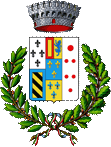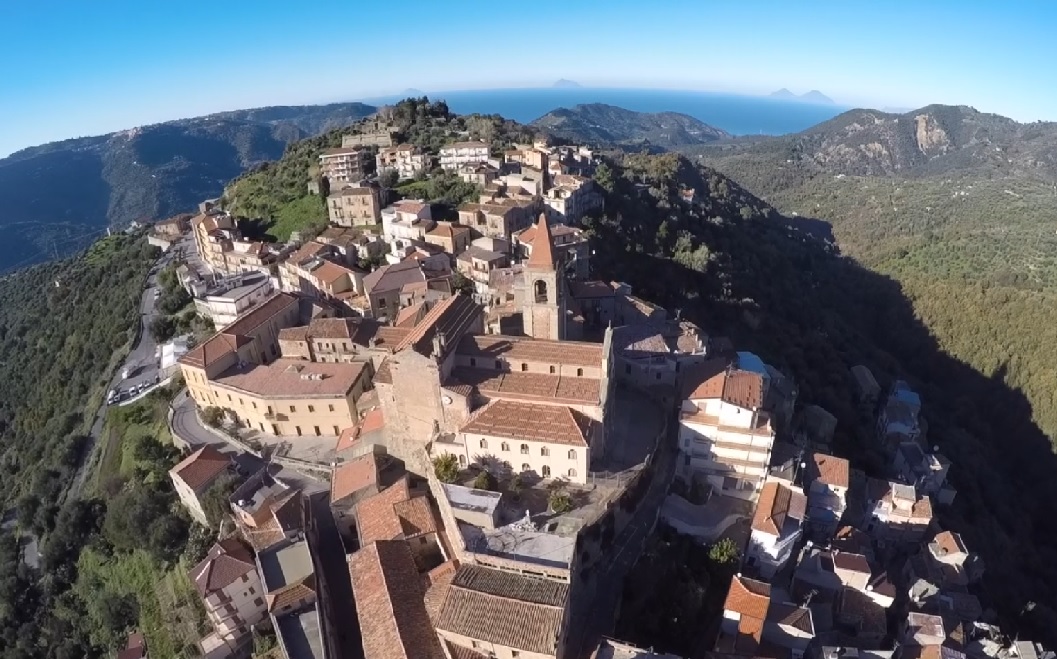

Il paese di Ficarra è posizionato nei Monti Nebrodi a 450 m. s.l.m., e su tre colline: una sud-occidentale ove è il centro (che a sua volta è sormontato dalla collina del Convento dei Cento Archi, da quella della Chiesa Madre e da quella della Fortezza Carceraria); una centrale, con le contrade di Serro, Crocevia e Pietra Zita; una nord-orientale Matini. A nord, nella pianura, troviamo le contrade Rinella, San Noto e Sauro.
Circa le origini del nome, si ritiene che il primo nucleo abitativo fu fondato dagli arabi con il nome di Al Fakhar (la gloriosa), oppure che possa derivare dalla numerosa presenza di coltivazioni di fichi (nel medioevo era indicato come "la Ficara", dal dialetto che significa "pianta di fico".
Secondo Diodoro Siculo, fu fondata dai Fenici con il nome di Pallisa (derivazione dalla dea Pallade), mentre i Greci Sicelioti provvidero a ricostruire il villaggio sulla collina "Strummuli". Ma il primo documento ufficiale è un diploma del 1082, del conte Ruggero I di Sicilia, in cui compare il nome di Ficarra. Il centro abitato sorse intorno ad una fortezza saracena, citata nei Registri della Chiesa di Messina del 1198. Testimonianza del periodo saraceno sono gli archi a sesto acuto presenti in alcune chiese. Nel 1072 esso divenne feudo baronale con funzioni di riserva di caccia. Con gli Svevi, il territorio passò a Guglielmo Amico, ma quando Federico II di Svevia morì, la vedova Macalda di Scaletta e il secondo marito, Alaimo da Lentini, divennero i nuovi proprietari. Macalda ebbe gravi scontri con la corona, per cui fu imprigionata, quindi la baronia passò a Don Ruggero di Lauria, erede di Guglielmo Amico ed a servizio degli aragonesi. Successivamente, i beni dei Lauria furono confiscati dalla corona e trasferiti al nobile Ugo Lancia di Brolo, padre di Blasco Lancia, e già Signore di Mongiolino,Galati e Longi. La famiglia Lancia lo governarono fino al 1738, quando Girolamo III Lancia di Brolo la vendette all'asta per 38.600 onze. Da allora, vari nobili costruirono palazzi nel paese, tra cui il Palazzo baronale di Ficarra.
Il paese ha una conformazione tipicamente medioevale con vicoli, viuzze e antichi palazzi.
Da visitare: il Convento dei Frati Minori Osservanti di S. Francesco, costruito nel XI sec. per i monaci di S. Basilio, caduti in disgrazia dopo la cacciata dei saraceni. Ricostruito, divenne la seconda biblioteca più importante della Sicilia. Nel 1886 iniziò il declino anche a causa del decreto dello stato che confiscò i beni ecclesiastici. Durante la Prima Guerra Mondiale divenne avamposto militare, ma a causa di una cannonata furono distrutti 99 dei suoi 100 archi a tutto sesto (era il Convento dei cento archi). Nel periodo fascista il chiostro divenne Parco delle Rimembranze, e fu posta una lapide per i caduti. Attualmente restano solo le mura perimetrali, il portale, l'abside e l'unico arco della Chiesa di S. Maria del Gesù; il Santuario Maria SS. Annunziata
di origine araba, di cui rimangono gli archi nella cripta, che risale al XIV sec. e oggi ha tre navate a croce latina. Ospita opere di A. Gagini. Le tre navate furono ricostruite dopo il terremoto del 1908. mentre la facciata risale al 1700 e presenta un importante rosone e la torre campanaria che alloggia un orologio; La Fortezza Carceraria, di cui non si hanno notizie certe prima del medioevo. Ha una struttura a pianta quadrata, con mura perimetrali in pietra arenaria e merli a coda di rondine. All'interno, c'è un cortile con un pozzo collegato ad una cisterna per la raccolta dell'acqua piovana. Dal 2011 è sede del Museo dei Giochi e del Giocattolo Medievale, con una interessante raccolta di riproduzioni di manufatti di uso medievale; i palazzi nobiliari costruiti dal seicento tra cui spiccano i palazzi Busacca, Baronale, Ferraloro e Milio.
Tra i prodotti tipici: l'Olio di oliva della Cultivar "Minuta", il rosolio, i "Pasti i Mennula" (dolci alla mandorla), i "Nuciddi" (nocciole), i "mennula 'nghiazzati" (mandorle con lo zucchero), i "Biscotta Livitati" o "Biscotta duri" (tipi di biscotti).
LINK: COMUNE DI FICARRA
(English)
The small town of Ficarra is located in the Nebrodi's Mountains on 450 m., on the sea level and on the three hills: the South-Western one, where is the center (which in turn it is topped from the hill of the Convent of the hundred arches, that of the mother church and that of the prison Fortress); a central one, with the districts of Serro, Crocevia and Pietra Zita: a North-Eastern one, Matini. In the North, in the plain, we can found the districts Rinella, San Noto and Sauro.
About the name origins, we are believed that the first settlement was foundes of the Arabs with the name of Al Fakhar (the glourious) or that it can derived from numerous presence of fig plantations (in the middle age was indicated as "la Ficara" from dialect that means "fig plant".
According Diodoro Siculo, it was founded by the Phoenician with the name of Pallisa (derivated from the goddess Pallade), while the Sicelioti Greeks provided to rebuilt the village on the hill "Strummuli". The first official document is a diploma of the 1082, of the count Ruggero I di Sicilia, in which appears the name of Ficarra. The inhabited center arose around a Saracen tower, mentioned in the Registries of the Church of Messina in the 1198. An evidence of the Saracen period are pointed arches presents in some churches. In the 1072 it became a baronial feudwith functions of hunting reserve. With the Swabian, the territory passed to Guglielmo Amico, but when Federico II di Svevia dead, the widow Macalda di Scaletta and the second husband, Alaimo da Lentini, became the new owners. Macalda had serious clashes with the crown, whereby she was imprisoned, therefore the barony passed to Don Ruggero di Lauria, heir of Guglielmo Amico and at the service of Aragoneses. Later, the Lauria's property was confiscated and transferred to the noble Ugo Lancia di Brolo, father of Blasco Lancia and already lordman of Mongiolino, Galati and Longi. The Lanciafamily governed it until 1738, when Girolamo III Lancia of Brolo sold at auction it for 38.600 onze. Since than, various nobles built palaces in the town, among them the baronial palace of Ficarra.
The village has a typical medieval conformation with alleys, little road and ancient palaces.
To visit: the Convento dei Frati Minori Osservanti di S.Francesco, built in the XIth century to the S. Basilio's monks, fallen in hard times after the expulsion of the Saracens. Rebuilt, it became the second library most important of Sicily. In 1886 it began its decline, also to cause of the decree of the state that confiscated the ecclesiastical goods. During the First World war it became military outpost, but to cause of a cannonade were destroyed 99 of its 100 round arches (it was the convent of the hundred arches). In the fascist period the cloister became Parco delle Rimembranze (Memorial Park) and a a plaque for the war deads was placed. Now only they remain the perimeter walls, the portal, the apse and the only arch of the Chiesa di S. Maria del Gesù; the Santuario Maria SS. Annunziata of arab origin, of which it remain only the arch of the crypt that dates back to XIVth century and now has three naves in the latin cross. It houses works of A. Gagini. The three naves were built after the hearthquake of 1908, while the facade dates back to 1700 and presents an important rose window and the bell tower that houses a clock; the Prison Fortress, of which there is non certain informations before middle age. It has a square plan structure, with perimeter walls in sandstone and dovetailed battlements. At the interior, there is a courtyard with a well connected with a cistern to collect rainwater. Since 2011 it is home to the Museo dei Giochi e del Giocattolo medievale, with an interesting collection of reproductions of medieval artefacts; the noble palaces built from seventeenth century among stands out the palaces Busacca, Baronale, Ferraloro and Milio.
Among the tipical products: l'Olio di oliva della Cultivar "Minuta" (olive oil), the rosolio (liqueur), the ""Pasti i Mennula" (almond cakes), the "Nuciddi" (hazelnuts), the "mennula 'nghiazzati" (almonds whit sugar), the "Biscotta livitati" or "Biscotta duri" (types of biscuits).